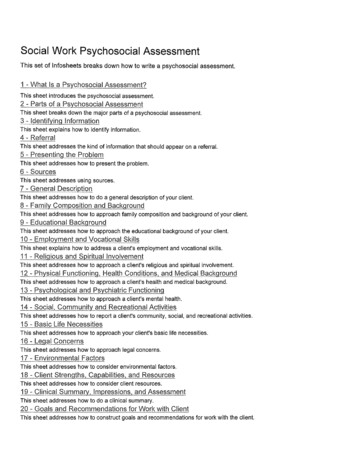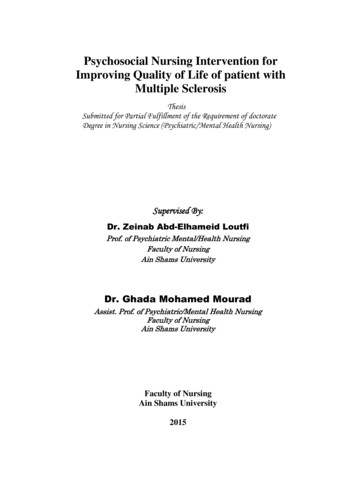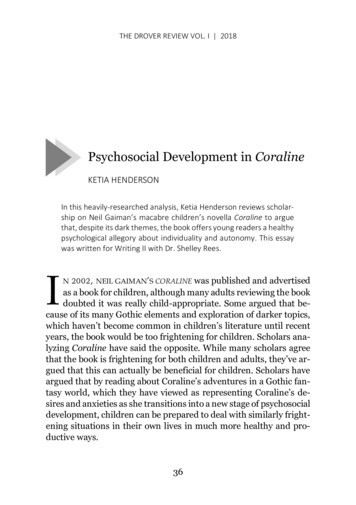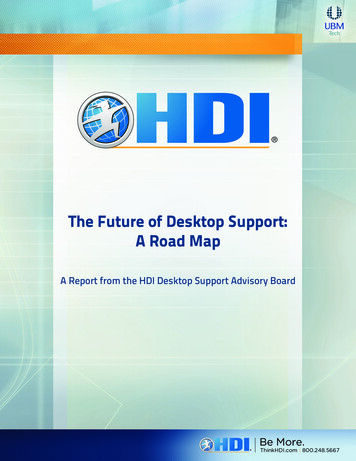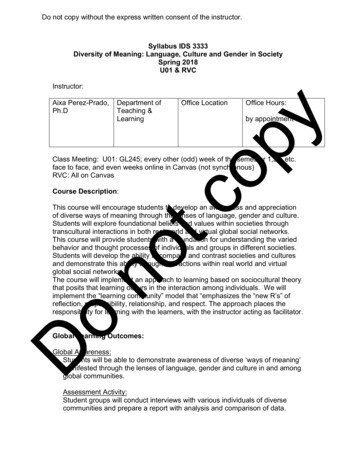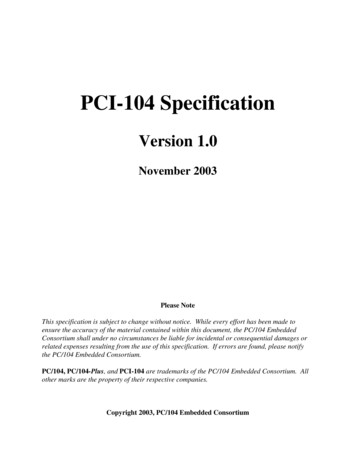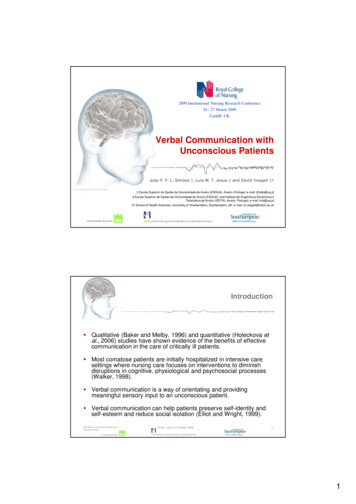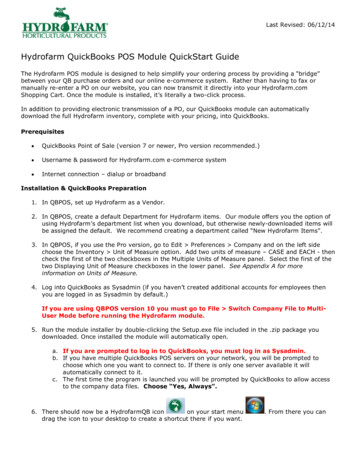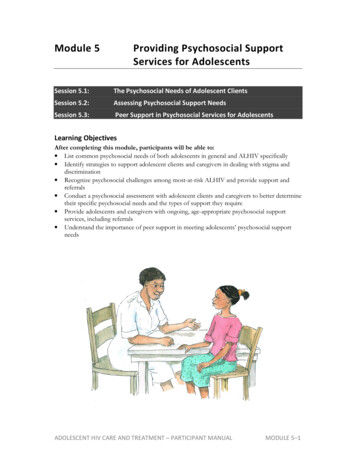
Transcription
Module 5Providing Psychosocial SupportServices for AdolescentsSession 5.1:The Psychosocial Needs of Adolescent ClientsSession 5.2:Assessing Psychosocial Support NeedsSession 5.3:Peer Support in Psychosocial Services for AdolescentsLearning ObjectivesAfter completing this module, participants will be able to: List common psychosocial needs of both adolescents in general and ALHIV specifically Identify strategies to support adolescent clients and caregivers in dealing with stigma anddiscrimination Recognize psychosocial challenges among most-at-risk ALHIV and provide support andreferrals Conduct a psychosocial assessment with adolescent clients and caregivers to better determinetheir specific psychosocial needs and the types of support they require Provide adolescents and caregivers with ongoing, age-appropriate psychosocial supportservices, including referrals Understand the importance of peer support in meeting adolescents’ psychosocial supportneedsADOLESCENT HIV CARE AND TREATMENT – PARTICIPANT MANUALMODULE 5–1
Session 5.1The Psychosocial Needs of AdolescentClientsSession ObjectivesAfter completing this session, participants will be able to: List common psychosocial needs of both adolescents in general and ALHIV specifically Identify strategies to support adolescent clients and caregivers in dealing with stigma anddiscrimination Recognize psychosocial challenges among most-at-risk ALHIV and provide support andreferralsOverview of Psychosocial SupportDefinition of psychosocial support and well being: “Psycho-” refers to the mind and soul of a person (involving internal aspects, such asfeelings, thoughts, beliefs, attitudes, and values). “Social” refers to a person’s external relationships and environment. This includesinteractions with others, social attitudes, values (culture), and the influence exerted by one’sfamily, peers, school, and community. Psychosocial support addresses the ongoing emotional, social, and spiritual concerns andneeds of people living with HIV, their partners, and their caregivers. Psychosocial well being is when a person’s internal and external needs are met and he orshe is physically, mentally, and socially healthy.Psychosocial well being is part of the mental health spectrum. Psychosocial support for ALHIVand families is discussed in this module and mental health, more generally, is discussed inModule 6.ADOLESCENT HIV CARE AND TREATMENT – PARTICIPANT MANUALMODULE 5–2
Psychosocial Support Needs of ALHIVAll adolescents have unique psychosocial needs, which are different from those ofchildren and adults. This is because adolescence is a unique stage of life that is characterizedby: Significant physical, emotional, and mental changes Risk-taking behavior and experimentation Sexual desire, expression, and experimentation Insecurity/confusion Anxiety Reactive emotions Criticism of caregivers or elders A focus on body image A sense of immortality A need to challenge authority figures while also still needing their supportRemember: ALL adolescents need support coping with normal developmental issues, such aswanting to feel normal and accepted and wanting to fit in with peers.On top of the psychosocial needs and challenges that all adolescents face, ALHIV mayalso experience HIV-related stressors, vulnerabilities, and challenges that can result inthe need for extra support. Adolescent clients may require extra support in the following areas,(among others): Understanding and coming to terms with their own HIV-status Understanding and coming to terms with family members’ HIV-status Grieving the illness or loss of parents and/or siblings and coping with added responsibilitiesat home Coping with cycles of wellness and poor health Long-term adherence to both care and medicines Disclosure to friends, family members, and sexual partners Sexual and reproductive health, including disclosure to partners, practicing safer sex, usingfamily planning, and making childbearing decisions Anxiety over physical appearance and body image Developing self-esteem, confidence, and a sense of belonging Dealing with stigma, discrimination, and social isolation Accessing education, training, and work opportunities Managing mental health issues, such as anxiety, depression, and substance abuse (see Module6 for more information about mental health and ALHIV)ADOLESCENT HIV CARE AND TREATMENT – PARTICIPANT MANUALMODULE 5–3
Figure 5.1: Support needs of ALHIVNote: This figure was adapted from: Uganda Ministry of Gender, Labour, and Social Development. (2005). Integratedcare for orphans and other vulnerable children: A training manual for community service providers.Providing psychosocial support to ALHIV and their caregivers is important because: All adolescents need support coping with normal developmental issues, such as wanting tofeel normal and accepted and wanting to fit in with peers. On top of the psychosocial needs and challenges that all adolescents face, ALHIV may alsoexperience HIV-related stressors and, in some cases, additional vulnerabilities and challenges. Psychosocial support can help clients and caretakers gain confidence in themselves and intheir coping skills. Adequate psychosocial support can increase clients’ understanding and acceptance of allcomprehensive HIV care and support services. Psychosocial well being is associated with better adherence to HIV care and treatment. HIV can be a chronic stressor that places ALHIV and their families at risk for mental healthproblems. Mental health and physical health are closely related (see Module 6). Ongoing psychosocial support may help prevent ALHIV from entering the “most-at-risk”category (discussed later in this session) or from developing more severe mental healthproblems.ADOLESCENT HIV CARE AND TREATMENT – PARTICIPANT MANUALMODULE 5–4
Overview of Stigma and DiscriminationStigma: Having a negative attitude toward people we think are not “normal” or “right.” Forexample, stigma can mean not valuing PLHIV or people associated with PLHIV.To stigmatize someone: Labeling or seeing a person as inferior (less than or below others)because of something about him or her. A lot of times people stigmatize others because they donot have the right information or knowledge. People also stigmatize others because they areafraid.Discrimination: Treating someone unfairly or worse than others because he or she is different(for example, because a person has HIV). Discrimination is an action that is typically fuelled bystigma.There are different kinds of stigma: Stigma toward others: Having a negative attitude about others because they are different orassumed to be different (for example, a boy with HIV who feels isolated at school because ofthe stigmatizing attitudes of his peers) Self-stigma: Taking on or feeling affected by the cruel and hurtful views of others. Often,self-stigma can lead to isolating oneself from family and community (for example, H isHIV-positive and is afraid of “giving the disease” to her family, so she keeps to herself andeats her meals alone.). Secondary stigma: When people are stigmatized because of their association with PLHIV.This may include community health workers; doctors and nurses at the HIV clinic; childrenof parents with HIV; and the caregivers and family members of PLHIV (for example, when achild’s friends no longer play with her at school or around the community because peoplehave heard that one of her family members is living with HIV).There are different forms of discrimination: Facing violence at home or in the community Not being able to attend school Being kicked out of school Not being able to get a job Being isolated or shunned from the family or community Not having access to quality health or other services Being rejected from a church, mosque, or temple Police harassment Verbal discrimination: gossiping, taunting, or scolding Physical discrimination: insisting a person use separate eating utensils or stay in a separateliving spaceStigma and discrimination deter access to HIV prevention, care, and treatment servicesfor many people. Stigma and discrimination can prevent people living with HIV,including adolescents, and their families from living a healthy and productive life.ADOLESCENT HIV CARE AND TREATMENT – PARTICIPANT MANUALMODULE 5–5
Effects of Stigma and DiscriminationStigma and discrimination can: Keep ALHIV from accessing care, treatment, counseling, and community support services(because they want to hide their status) Cause a great deal of anxiety, stress, and/or depression Make adolescents feel isolated and as if they do not fit in with peers Make it difficult for ALHIV to succeed in school Result in poor adherence to medications Make it hard for people to tell their partner(s) their status Make it hard for people to discuss safer sex with partners Make it hard for parents to disclose their own HIV-status to their children and also forcaregivers to tell HIV-infected children their HIV diagnosis Discourage pregnant women from taking ARVs or accessing other PMTCT services Prevent people from caring for PLHIV in their family, in the community, and in health caresettings Impact some adolescents more than others. For example, orphans living with HIV mayencounter hostility from their extended families and community and may be rejected, deniedaccess to schooling and health care, and left to fend for themselves.ADOLESCENT HIV CARE AND TREATMENT – PARTICIPANT MANUALMODULE 5–6
Strategies to Deal with Stigma and DiscriminationIndividual strategies for dealing with stigma: Stand up for yourself! Educate others. Be strong and prove yourself. Talk to people with whom you feel comfortable. Join a support group. Try to explain the facts. Ignore people who stigmatize you. Avoid people who you know will stigmatize you. Taking and adhering to ART and other medicines reduces stigma around HIV, helpsnormalize HIV, and allows the community to see HIV as a chronic disease. People whoopenly take ART can reduce stigma around the disease.Strategies for dealing with stigma within health care settings: Make sure PLHIV and ALHIV, such as Peer Educators, are part of the care team. Thisincludes making sure that they attend regular staff meetings, trainings, and other events. Make sure young people are given opportunities to evaluate clinical services and thatfeedback is formally reviewed by managers and health workers. Ensure that there are linkages with community-based youth groups and support groups forALHIV; refer adolescents to these groups. Talk openly with other health workers about your own attitudes, feelings, fears, andbehaviors. Support each other to address fears and avoid burnout. When you witness discrimination in the health care setting, challenge it. For example, if yousee a colleague being rude to a client with HIV, talk to this colleague on a one-to-one basisafter the client leaves. Tell him or her what you saw and how you think the situation couldhave been handled differently. Report to the manager any discrimination in the clinic setting that is directed toward PLHIVor their families. Listen to clients when they talk about their feelings and concerns about stigma anddiscrimination and report what you learn back to other health workers. Work with other members of the multidisciplinary team to identify where stigma anddiscrimination exist in the clinic and work together to make changes.ADOLESCENT HIV CARE AND TREATMENT – PARTICIPANT MANUALMODULE 5–7
Overview of Most-at-Risk ALHIV1,2Worldwide, all adolescents are vulnerable and at-risk because: Young people’s behavior is less fixed than that of adults. Drug use and certain sexualpractices are sometimes experimental and may or may not continue. Young people are less likely than older adults to identify themselves as drug users or sexworkers. This makes them both harder to reach with programs and less responsive tocommunication addressed to groups with specific identities. Young people are more easily exploited and abused. Young people, especially girls, are the most common victims of gender-based violence orGBV (see Module 10 for more information). Many young women are also vulnerable to transactional sex and its consequences (see boxbelow). Young people have less experience coping with marginalization and illegality. Young people may be less willing to seek out services — and providers may be less willing toprovide them with services — due to concerns about the legality of behaviors and informedconsent. Young people are often less oriented toward long-term planning and thus might not thinkthrough the risks that are related to the choices they make. Many adolescents are living without parental guidance or support. There is a lack of accessible health, social, educational, and legal resources for adolescents. Adolescents might live in societies or communities where laws, cultural practices, or socialvalues force young people to behave in ways that place them at risk. Examples include thepresence of homophobia, female genital cutting, or norms that encourage adolescent girls tohave sex with older men.Transactional sex: putting young women at riskTransactional sex is the exchange of sex for money, goods, or services. Significant agedisparities are common in partners who engage in transactional sex. Among other factors,concerns about HIV have prompted older men to seek younger sexual partners because theyassume these partners are less likely to be HIV-infected. Young women are often willing toparticipate in these partnerships for emotional reasons; perceived educational, work, or marriageopportunities; monetary and other material gifts; or basic survival. They often fail to realizetheir vulnerability to abuse, exploitation, reproductive health risks, and HIV. Transactionalsex puts girls and young women at risk of physical and emotional abuse, exploitation,and a range of sexual and reproductive health problems.ADOLESCENT HIV CARE AND TREATMENT – PARTICIPANT MANUALMODULE 5–8
Most-at-risk ALHIV include young people who are both HIV-positive and particularlyvulnerable or at risk, such as those who are homeless, homosexual or bisexual, trans-gendered,disabled, imprisoned, caregivers, orphans, migrants, refugees, gang members, sex workers, orinjecting drug users. Most-at-risk adolescents maylive in especially difficult circumstances and typically “Most-at-risk” refers to behaviors, whileexperience enormous challenges in meeting their“vulnerability” refers to the circumstancesown basic needs for food, shelter, and safety.and conditions that make most-at-riskbehaviors more likely.Young people who most need support often havethe most difficulty accessing services and adopting behaviors that will protect them from HIV.The behaviors that put them at risk (for example, exchanging sex for money, food, or shelter) areusually heavily stigmatized, frequently take place in secret, and are often illegal.Existing policies and legislation, lack of political support, and other structural issues oftenprevent most-at-risk adolescents from receiving the services they need. This contributes to thefurther marginalization of these young people and undermines their confidence in health andsocial services, as well as their willingness to make contact with service providers.Most-at-risk ALHIV may require increased psychosocial support due to extremechallenges, such as: DisplacementNon-violence: a human right Severe social exclusion and isolationEnsure that all clients, particularly those Stigma and discriminationwho are most-at-risk, recognize that theyhave a right to say "no" to sex and a right to Extreme povertylive in a world without abuse. Encourage Substance abusethem to recognize that violence and forced Physical or sexual abuse/violencesex is not only wrong but also unethical and Exploitationpunishable by law. Migration Stigma, discrimination, violence, and fear of arrest due to sexual orientation Chronic mental health issues, psychiatric disorders, and learning disorders Disabilities A stressful past: many situations and events that push youth into vulnerable circumstances inthe first place (like parental illness and death, lack of substitute parental care, abuse, etc.) mayhave a lasting impact on their well beingADOLESCENT HIV CARE AND TREATMENT – PARTICIPANT MANUALMODULE 5–9
Session 5.2Assessing Psychosocial Support NeedsSession ObjectiveAfter completing this session, participants will be able to: Conduct a psychosocial assessment with adolescent clients and caregivers to better determinetheir specific psychosocial needs and the types of support they requireConducting a Psychosocial AssessmentSee Appendix 5A: Psychosocial Assessment Tool.Tips to remember during the psychosocial assessment process: Emphasize that all information isFamily-centered care versus client confidentialityconfidential and private, but thathealth workers may share some ofIt is important to ensure the inclusion of caregivers andthe information with otherother family members in care. However, it is equallyproviders in the clinic to ensureimportant that private information discussed during anindividual session with an ALHIV remains confidential andthe best care for the client.is not shared with caregivers (unless the adolescent Conduct the assessment in a spacespecifically consents). Unless clients have a guarantee ofthat has visual and auditoryconfidentiality, they will be unwilling to discussprivacy.personal issues. Involve the adolescent during allphases of the assessment process. Respect the dignity and worth of the adolescent at all times. Do not talk down to the adolescent. Use good listening and learning skills, as discussed inModule 4. Always be positive! Offer lots of encouragement and praise throughout the assessment. Be patient! Allow the adolescent to speak for him- or herself. Allow the client to express hisor her views and to describe his or her experiences. Respect the adolescent’s coping skills and his or her ideas and solutions to problems. Do not judge! Make adolescents feel comfortable instead of fearful that they will be punishedor judged — especially if they openly discuss challenges. Offer to include caregivers’ and/or family members’ input into the assessment as needed andagreed upon by the adolescent, while simultaneously protecting the confidentiality ofinformation. Keep good records. Always keep a copy of the psychosocial assessment in the client’s file.ADOLESCENT HIV CARE AND TREATMENT – PARTICIPANT MANUALMODULE 5–10
Overview of Coping StrategiesHealth workers should use the 5 “A’s” when conducting psychosocial assessment withclients: ASSESS, ADVISE, AGREE, ASSIST, and ARRANGE. Note that the 5 “A’s” werealso covered in Module 3; these are part of the WHO IMAI guidelines on working with clientswith chronic conditions, including HIV. See Table 5.1 for a review of the 5 “A’s.”Table 5.1: Using the 5 “A’s” during clinical visits with adolescents, including psychosocialand counseling sessions (the 5 “A’s” were also covered in Module 3)The 5“A’s”More InformationAssess the client’s goals for the visitAsses the client’s clinical status, classify/identifyrelevant treatments, and/or advise and counselAssess risk factorsAssess the client’s (caregiver’s) knowledge,beliefs, concerns, and behaviorsAssess the client’s understanding of the care andtreatment planAssess adherence to care and treatment (seeModule 8)Acknowledge and praise the client’s effortsUse neutral and non-judgmental languageCorrect any inaccurate knowledge and gaps inthe client’s understandingCounsel on risk reductionRepeat any key information that is neededReinforce what the client needs to know tomanage his or her care and treatment (forexample, recognizing side effects, adherencetips, problem-solving skills, when to come tothe clinic, how to monitor one’s own care,where to get support in the community, etc.)Negotiate WITH the client about the care andtreatment plan, including any changesPlan when the client will return Provide take-away information on the plan,including any changes Provide psychosocial support, as needed Provide referrals, as needed (to support groups,peer education, etc.) Address obstacles Help the client come up with solutions andstrategies that work for him or her Arrange a follow-up appointment Arrange for the client to participate in a supportgroup or group educations sessions, etc. Record what happened during the visit ASSESS AGREEADVISE ASSIST ARRANGEWhat the Health Worker Might Say What would you like to address today?What can you tell me about ?Tell me about a typical day and how you deal with?Have you ever tried to ? What was that likefor you?To make sure we have the same understanding, canyou tell me about your care and treatment plan, inyour own words?Many people have challenges taking their medicinesregularly. How has this been for you?I have some information about that I’d liketo share with you.Let’s talk about your risk related to . Whatdo you think about reducing this risk by .What can I explain better?What questions do you have about ?We have talked about a lot today, but I think we’veagreed that . Is this correct?Let’s talk about when you will return to the clinicfor .Can you tell me more about any obstacles you’vefaced with (for example, taking yourmedicines regularly, seeking support, practicing safersex)?How do you think you can overcome this obstacle?What questions can I answer about ?I want to make sure I explained things well — canyou tell me in your own words about ?I would like to see you again in for .It’s important that you come for this visit or let usknow if you need to reschedule.What day/time would work for you?Sources:WHO. (2004). General principles of good chronic care: IMAI. Guidelines for first-level facility health workers.WHO. (2010). IMAI one-day orientation on adolescents living with HIV.ADOLESCENT HIV CARE AND TREATMENT – PARTICIPANT MANUALMODULE 5–11
Note: If, during the “ASSESS” phase, a health worker thinks the adolescent client hasserious issues that threaten his or her life or immediate safety (such as homelessness,thoughts of suicide, signs of severe depression, violence, etc.), these issues must beaddressed IMMEDIATELY. In these emergency cases with most-at-risk adolescents, working through the 5 “A’s” shouldnot be the priority. Instead, the health worker should focus on the client’s immediate safety and well being. Note that in these emergency situations, health workers may need to break confidentiality inorder to take actions that are in the best interest of the adolescent and that ensure his or herimmediate safety. Managing emergency situations is discussed further in Module 6.Once the health worker has assessed that there are no emergency issues threatening the client’simmediate safety and well being, the health worker can suggest coping strategies to the clientand his or her caregivers to help them reduce stress, deal more effectively with challenges, andpromote their psychosocial well being.Examples of coping strategies include: Talking about a personal problem with someone trusted, such as a friend, family member,counselor, or Peer Educator Seeking help from clinic staff, especially if sad, depressed, or anxious for a long period oftime (see Module 6 for more information about mental health and ALHIV) Joining a support group Changing one’s environment, taking a walk, or listening to music Seeking spiritual support Attending a cultural event, like traditional dancing or singing Participating in recreational activities, like sports or youth clubs Returning to a daily routine, including doing household chores (e.g. cooking) or going toschool Doing something to feel useful, like helping a sibling with homeworkHelping clients express themselves and encouraging them to tell their stories and toshare their problems also helps them to: Feel a sense of relief Reduce feelings of isolation Think more clearly about what has happened Feel accepted, cared for, and valued Develop confidence Build self esteem Explore options or solutions to make better decisions Prevent bad feelings from coming out as aggressive behavior Maintain needed support from family members and other adultsADOLESCENT HIV CARE AND TREATMENT – PARTICIPANT MANUALMODULE 5–12
An important part of helping adolescents cope with issues is encouraging theircaregivers to strengthen their relationship with them. Health workers can suggest thatcaregivers: Spend time with and listen to the adolescent. Let the adolescent know that their feelings are normal and “OK.” Encourage them to talkand express feelings and thoughts. Listen actively. Communicate unconditional love and acceptance. Help the adolescent plan daily or weekly activities. Involve the adolescent in family activities as much as possible. Relax. It is important for both the adolescent and the family to learn to relax both physicallyand mentally. Get enough rest and eat well. Get professional help from a counselor or social worker. Be aware of changes in behavior or mood and look for signs of mental illness, includingalcohol and other substance use (discussed more in Module 6). Talk to someone; family members may also be depressed and need help. Get help from a support organization in the community. Continue their regular religious or spiritual practices.ADOLESCENT HIV CARE AND TREATMENT – PARTICIPANT MANUALMODULE 5–13
Exercise 1: Assessing Psychosocial Support Needs: Case studies in small groups and largegroup discussionPurposeTo discuss how to the asses the psychosocial needs of adolescentsusing Appendix 5A: Psychosocial Assessment Tool and by applying the5 “A’s”Refer to Appendix 5A: Psychosocial Assessment Tool and the 5 “A’s” in Table 5.1.Case Study 1:A 17-year-old woman named T tested positive for HIV 6 months ago. She is currentlycaring for her 3 younger sisters with the help of her grandmother. She is so busy that she hasmissed a couple of appointments at the ART clinic, including refill appointments for ARVs.Her partner is the only one who knows she is HIV-positive, but he himself has not beentested. How do you proceed with T today?Case Study 2:A 12-year-old boy named M has comes to the clinic today with his mother. He looks likehe is “feeling down.” You sense that he wants to talk to someone, but he seems very quietand won’t make eye contact with anyone. How do you proceed with M ?Case Study 3:K is a 17-year-old young woman living with HIV. Her mother died when she was 5 yearsold and she doesn’t know her father. For the last year, K has been living with her 28year-old boyfriend. She has come to the clinic today because she thinks she is pregnant. Howwould you proceed with K ?ADOLESCENT HIV CARE AND TREATMENT – PARTICIPANT MANUALMODULE 5–14
Session 5.3Peer Support in Psychosocial Services forAdolescentsSession ObjectiveAfter completing this session, participants will be able to: Understand the importance of peer support in meeting adolescents’ psychosocial supportneedsImportance of Peer Support for ALHIVAdolescents generally depend on peers for information, approval, and connection. In addition tothe other psychosocial support strategies described in this module, peer support can helpALHIV counter stigma and discrimination, cope with fear and hopelessness after diagnosis,improve adherence to care and treatment services, and deal with issues like disclosure topartners, friends, and family.The engagement of ALHIV as Adolescent Peer Educators can play an important role inimproving adherence and service quality. See Module 12 for more information on thebenefits of adolescent peer education programs and on how to implement such programs.Adolescent Peer Educators can help improve services for ALHIVFull participation of Adolescent Peer Educators in the health facility and in outreach services canexpand the clinic’s ability to provide quality care to adolescents by allowing already overburdenedhealth workers to concentrate on more technical tasks.It should be noted, however, that there are some significant differences between Adult andAdolescent Peer Educators, ranging from their availability to their attention span, brain function,and decision-making. Thus, expectations of Adolescent Peer Educators and their supervisorystructures must also be different from those of Adult Peer Educators, expert clients, and laycounselors. Adolescents, usually self-conscious because of their age, inexperience, and outsiderstatus, try hard to fit into adult environments. When they are successful, it can be easy to forgetthat they are not adults. However, when they are under stress, the mask of adulthood may slip,revealing their youth along with their need for close supervision and guidance.ADOLESCENT HIV CARE AND TREATMENT – PARTICIPANT MANUALMODULE 5–15
Depending on the context and program, Adolescent Peer Educators can play a numberof important roles in HIV service delivery, including but not limited to (see Module 12also): Providing counseling and long-term support (related to adherence preparation, adherencefollow-up, disclosure, positive living, positive prevention, etc.) Providing psychosocial support to clients and family members Leading health talks and group education sessions with ALHIV, caregivers, treatmentsupporters, and others Assisting clients with disclosure Linking young pregnant women living with HIV to ANC and PMTCT services Assisting clients with referrals from place to place, within or between health facilities Providing referrals and linkages to community-based services and support Tracing clients who miss appointments or who have been lost to follow-up Serving as a communication link between clients and health workers Participatin
Young people, especially girls, are the most common victims of gender-based violence or GBV (see Module 10 for more information). Many young women are also vulnerable to transactional sex and its consequences (see box below). Young people have le
